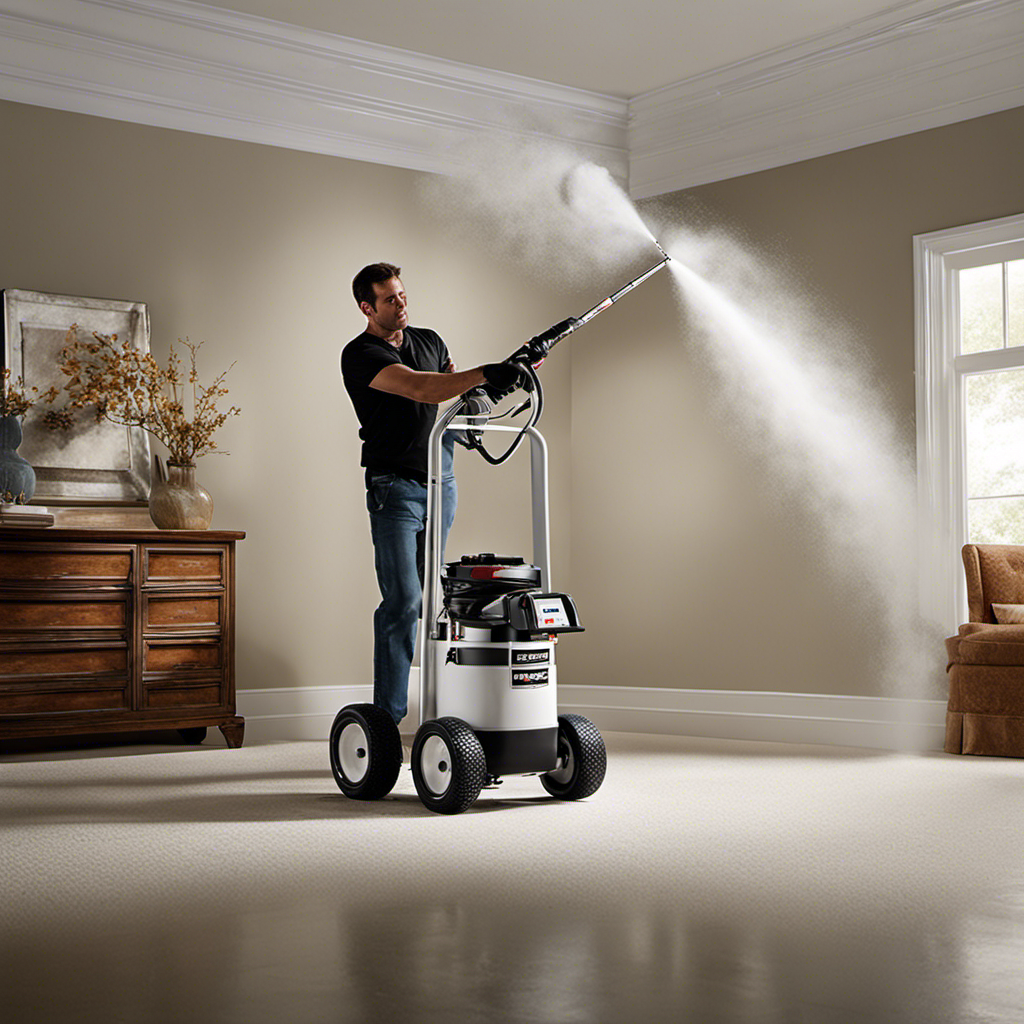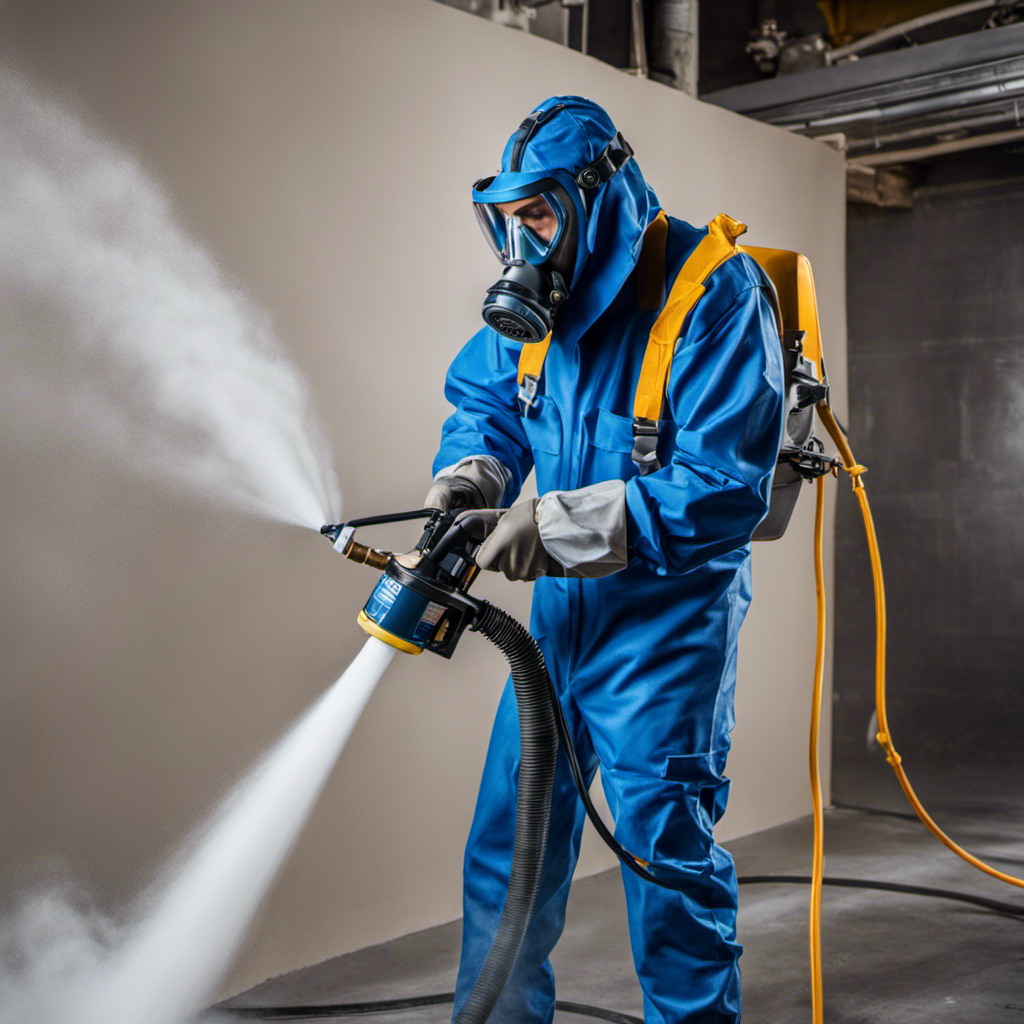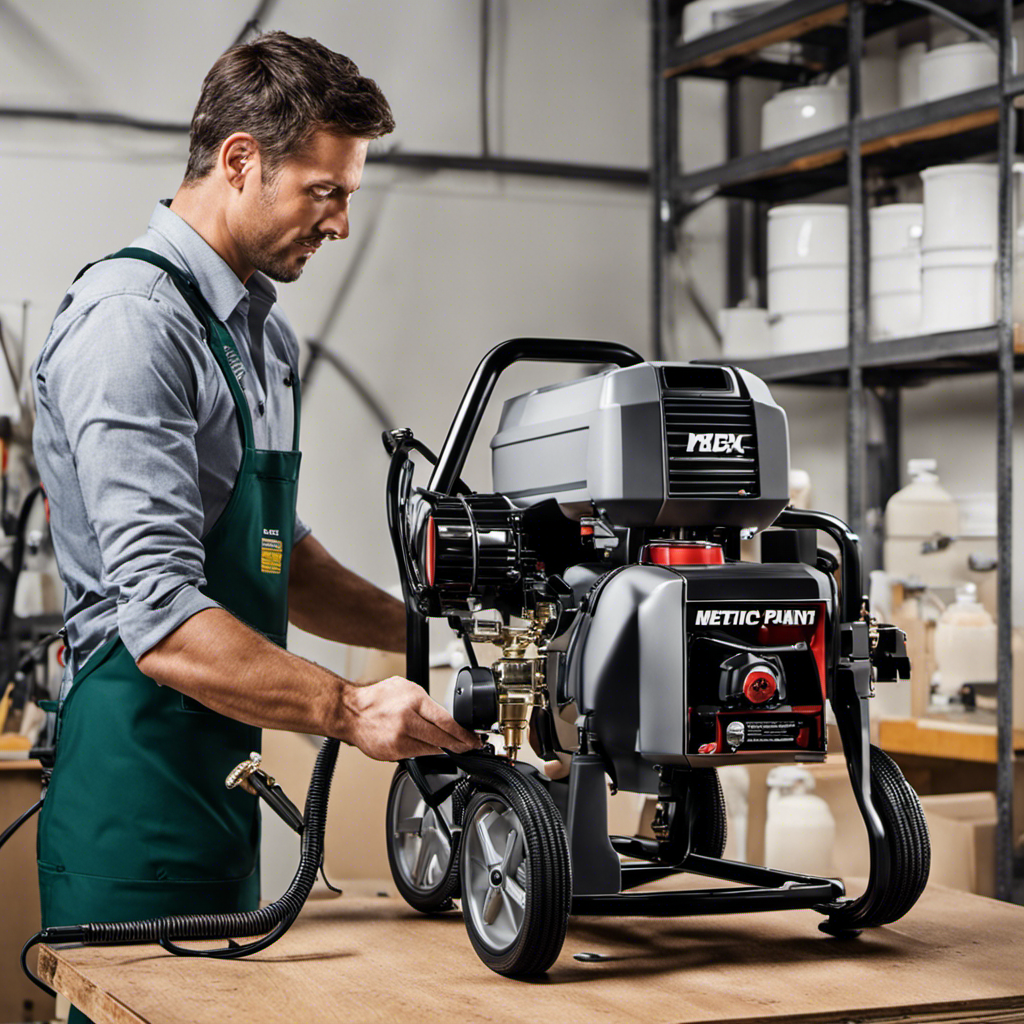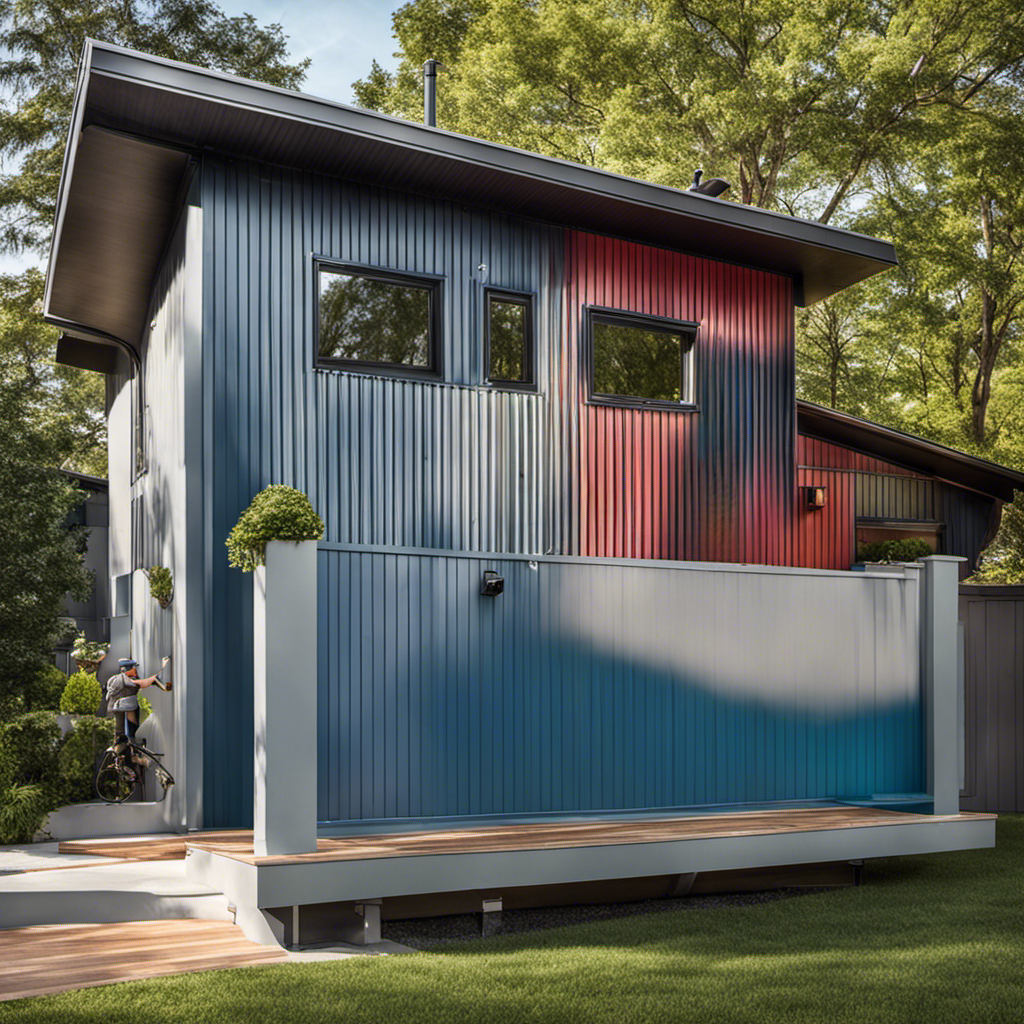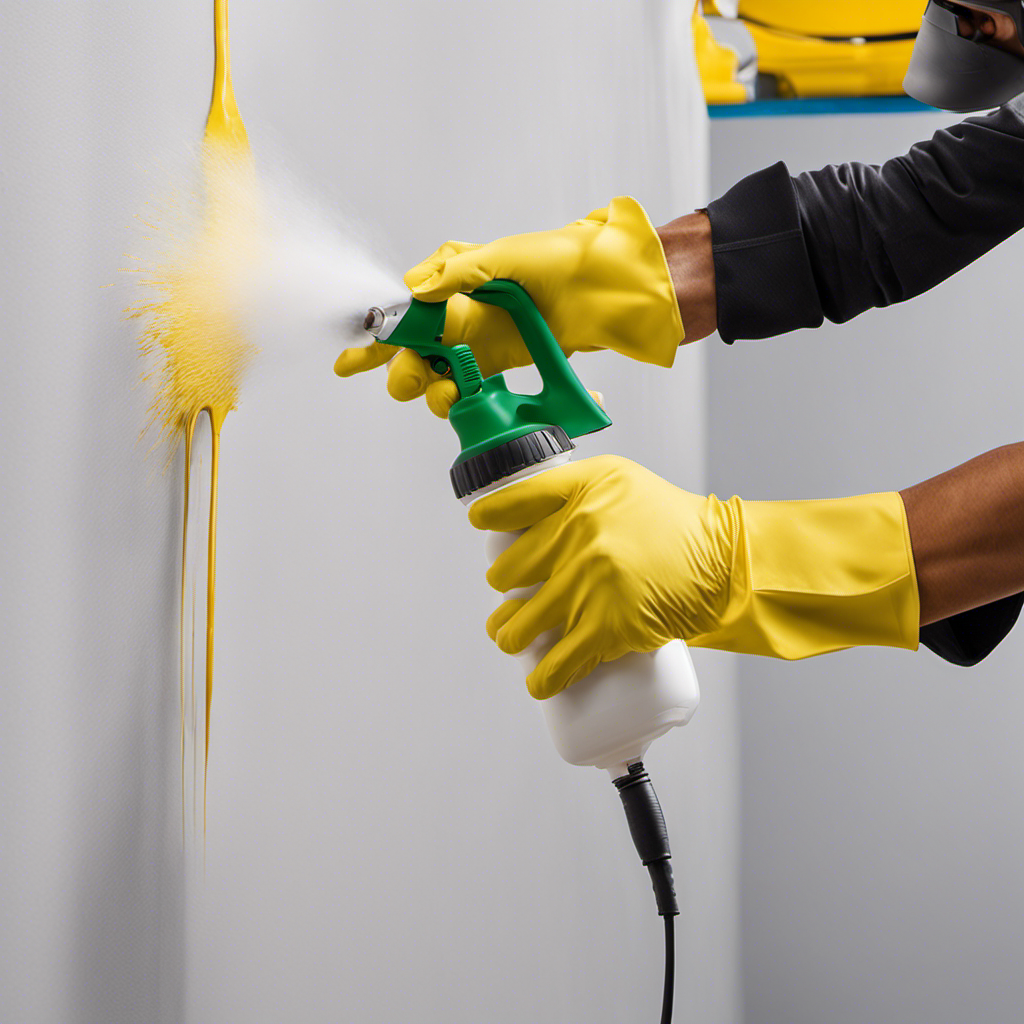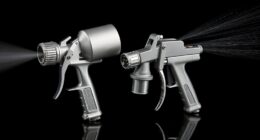Contractors prefer airless sprayers for their effectiveness and their capability to produce top-notch results. It is essential to conduct regular maintenance to keep these portable and commercial-grade sprayers performing at their peak and to prolong their lifespan.
Thinning house paint correctly is crucial when using airless sprayers, as it can boost paint coverage by up to 30%. Different paints, like oil-based paints and varnishes, often need thinning for smoother finishes.
Following manufacturers’ instructions and taking safety precautions are essential for achieving optimal paint performance. Troubleshooting common issues, like clogging or overspray, is also important.
Key Takeaways
- Regular maintenance is crucial for optimal performance and longevity of airless sprayers.
- Thinning paint properly before using it with a sprayer is crucial for optimal performance.
- Thinning allows paint to be sprayed at a lower pressure, reducing overspray and minimizing the risk of clogging the sprayer.
- Different types of paint may require different levels of thinning, so it is important to follow manufacturers’ recommendations for thinning ratios.
Understanding the Benefits of Airless Sprayers
Contractors rely on airless sprayers for their efficient and high-quality painting projects, making them the go-to choice for optimal performance. When it comes to large projects, airless sprayers offer numerous benefits.
The advantages of professional-grade airless sprayers are particularly noteworthy. These sprayers are designed to handle heavy-duty work and provide consistent and even coverage. With their powerful motors and high-pressure capabilities, professional-grade airless sprayers can handle a wide range of paints and coatings, including thick and viscous materials. They also have larger paint capacities, allowing contractors to complete larger areas without frequent refills.
Additionally, professional-grade airless sprayers are built to withstand heavy use and offer durability, ensuring long-term performance and reliability. Overall, these sprayers are essential tools for contractors seeking efficiency and superior results in their painting projects.
Different Models of Airless Sprayers
Painting professionals rely on a variety of airless sprayer models, including handheld and professional-grade options, to achieve efficient and high-quality results. These sprayers are essential tools for large-scale painting projects, as they provide a consistent and even application of paint.
To maintain optimal performance, regular airless sprayer maintenance is necessary. This includes cleaning filters, checking for worn-out parts, and lubricating moving components. However, even with proper maintenance, issues may arise.
Common airless sprayer troubleshooting includes clogging, uneven spray patterns, and inconsistent pressure. Troubleshooting these problems often involves adjusting the viscosity of the paint, cleaning the spray tip, and ensuring proper masking and protection.
Importance of Regular Maintenance for Optimal Performance
Regular maintenance is crucial for ensuring that airless sprayers operate at their best and have a long lifespan. Neglecting maintenance can lead to issues such as clogging, uneven spray patterns, and reduced performance. By following a regular maintenance routine, users can troubleshoot common issues and optimize the performance of their airless sprayers. Below is a table outlining the importance of regular maintenance and common troubleshooting techniques:
| Importance of Regular Maintenance | Troubleshooting Common Issues |
|---|---|
| Checking for worn-out parts | Clogging |
| Cleaning filters | Uneven spray patterns |
| Lubricating moving components | Reduced performance |
Troubleshooting Common Issues With Airless Sprayers
To effectively troubleshoot common issues with airless sprayers, users should first check for clogs in the spray tip and adjust the viscosity of the paint if needed.
Clogging issues can occur when debris or dried paint particles accumulate in the spray tip, obstructing the flow of paint. To address this, users should remove the spray tip and clean it thoroughly using a brush or a specialized cleaning solution. If the clog persists, users may need to replace the spray tip altogether.
Additionally, uneven spray patterns can indicate an issue with the viscosity of the paint. If the paint is too thick, it may not atomize properly and result in uneven coverage. In such cases, users should consult the manufacturer’s instructions for the recommended viscosity range and adjust accordingly by adding the appropriate thinner or solvent to the paint.
Proper Thinning Techniques for Airless Sprayers
Achieving the desired consistency is crucial when thinning paint for optimal results with airless sprayers. Proper thinning techniques ensure that the paint flows smoothly through the sprayer and provides an even and professional finish.
To achieve the right consistency, it is important to follow the manufacturer’s recommended thinning ratios. These ratios are specific to each type of paint and are designed to achieve the best results. Gradually thin the paint by adding small amounts of thinner at a time, stirring the mixture consistently until it reaches a smooth and even consistency.
Conducting a test spray on a small area before starting the project can help ensure that the paint is thinned correctly. By following the recommended thinning ratios and achieving the desired consistency, painters can optimize the performance of their airless sprayers.
Thinning House Paint for Improved Coverage
Thinning house paint properly can significantly improve coverage, allowing for a smoother and more even finish. When using airless sprayers, the benefits of proper thinning become even more apparent.
Airless sprayers are known for their efficiency and high-quality results, making them a contractor’s go-to choice. However, troubleshooting airless sprayer issues is crucial for optimal performance. Clogging or uneven spray patterns can be common problems, but regular maintenance can help prevent these issues.
Cleaning filters, checking for worn-out parts, and lubricating moving components are all part of the maintenance routine. Thinning paint before using it with a sprayer is also important. It increases the coverage by up to 30% and allows for a lower pressure, reducing overspray and minimizing the risk of clogging.
Following manufacturers’ recommendations and conducting test sprays are key steps in achieving the perfect consistency for optimal results.
Types of Paint That Require Thinning
Different types of paint, such as oil-based paints, varnishes, and certain specialty coatings, often require thinning for optimal spraying results. Thinning techniques are essential for achieving consistency in the paint and ensuring a smooth and even application through airless sprayers. The table below provides an overview of the types of paint that typically require thinning and the recommended thinning ratios for each.
| Type of Paint | Thinning Ratio |
|---|---|
| Oil-Based Paints | 10-20% paint thinner to paint |
| Varnishes | 10-20% mineral spirits to varnish |
| Specialty Coatings | Follow manufacturer’s instructions |
It is important to follow the manufacturer’s recommendations for thinning ratios to avoid issues such as overspray or clogging the sprayer. Achieving the right consistency ensures smooth flow and atomization of the paint, resulting in a professional finish. Gradually adding small amounts of thinner to the paint and conducting a test spray on a small area are good practices to determine the optimal thinning level. By using proper thinning techniques, painters can achieve consistent and high-quality results with their airless sprayers.
Determining the Right Consistency for Thinning
Contractors need to pay attention to the recommended thinning ratio in order to determine the right consistency for optimal spraying results. To ensure successful paint application with airless sprayers, it is essential to test the consistency and troubleshoot any issues that may arise.
Here are three key factors to consider:
-
Conduct Consistency Testing: Contractors should conduct a test spray on a small area before starting the project. This allows them to evaluate the flow and atomization of the paint, ensuring a smooth and even finish.
-
Follow Manufacturer’s Recommendations: Manufacturers provide specific guidelines for thinning ratios, which should be closely followed. Adhering to these recommendations guarantees that the paint will flow effortlessly through the sprayer, resulting in efficient and high-quality spraying.
-
Troubleshoot Issues: If problems arise during spraying, contractors should adjust the viscosity of the paint by adding small amounts of thinner at a time. Additionally, cleaning the spray tip and using masking tape and drop cloths for protection can help prevent clogging and overspray.
Tips for Using Airless Sprayers Safely
After determining the right consistency for thinning the paint, it is essential to understand how to safely use airless sprayers. Proper maintenance and troubleshooting are crucial to ensure optimal performance and longevity of the sprayer. To assist users, here are some practical tips for using airless sprayers safely:
| Tips for Using Airless Sprayers Safely |
|---|
| 1. Always wear protective clothing, gloves, and goggles when operating the sprayer. |
| 2. Ensure proper ventilation in the work area and consider using a respirator mask if necessary. |
| 3. Start with a lower pressure setting on the sprayer and gradually increase if needed. |
| 4. Regularly clean the spray tip to prevent buildup and maintain consistent spray patterns. |
Proper Spraying Techniques for a Smooth Finish
To achieve a smooth finish, users should practice proper spraying techniques when using airless sprayers. Here are three key points to consider:
-
Spray Pattern Adjustments: Adjusting the spray pattern is crucial for achieving an even and uniform coat of paint. Users should familiarize themselves with the sprayer’s settings and make necessary adjustments to control the width and shape of the spray pattern. This ensures that the paint is distributed evenly on the surface, minimizing the risk of streaks or uneven coverage.
-
Troubleshooting Overspray: Overspray can occur when the spray pattern is not properly controlled, leading to wastage of paint and potential damage to nearby objects. To troubleshoot overspray, users should ensure that the sprayer is held at the correct distance from the surface and that the pressure is adjusted appropriately. Additionally, using masking tape and drop cloths to protect surrounding areas can help contain the overspray.
-
Proper Technique: Users should employ a steady and smooth motion when operating the sprayer. Starting and stopping abruptly can result in uneven application and visible lines. Maintaining a consistent speed and distance from the surface is essential for achieving a professional-looking finish. Practice and experience will help users master the proper spraying technique and achieve excellent results.
Cleaning and Maintenance Tips for Airless Sprayers
Regular cleaning and maintenance are essential for keeping airless sprayers in optimal condition and prolonging their lifespan. To ensure the longevity and performance of an airless sprayer, it is crucial to follow proper cleaning tips and maintenance techniques.
After each use, the sprayer should be thoroughly cleaned to remove any paint residue or debris. This can be done by flushing the system with clean water or an appropriate cleaning solution.
Additionally, regular maintenance should include checking and replacing worn-out parts, such as filters and seals, as well as lubricating the moving components to ensure smooth operation.
Choosing the Right Paint for Airless Spraying
Users can achieve optimal results with airless sprayers by selecting the appropriate paint for their projects. To choose the right paint for airless spraying, it is important to understand paint viscosity and the different types of paint available.
Here are three key points to consider:
-
Paint Types: Different paints have different properties and are suitable for specific applications. Users should choose paint types that are specifically formulated for airless spraying. High-quality paint brands like Sherwin-Williams, Behr, and Benjamin Moore offer durable and high-coverage options that are ideal for airless spraying.
-
Understanding Paint Viscosity: Paint viscosity refers to its thickness or consistency. It is important to choose a paint with the right viscosity for airless spraying. Thin paints may require less thinning, while thicker paints may need more thinner. Manufacturers often provide recommendations for thinning ratios to achieve the optimal viscosity for airless spraying.
-
Test and Adjust: Before starting a project, users should conduct a test spray on a small area to ensure the chosen paint works well with their airless sprayer. If necessary, adjustments can be made to the viscosity by adding small amounts of thinner to achieve the desired flow and atomization.
Frequently Asked Questions
What Are Some Common Safety Precautions to Take When Using an Airless Sprayer?
Airless sprayer safety precautions involve following best practices to ensure a safe and efficient painting experience. Users should wear protective clothing, gloves, and goggles to protect against paint splatter and fumes. Adequate ventilation is crucial, and a respirator mask should be used if necessary.
It is important to clean the spray tip regularly to prevent clogging and adjust the viscosity of the paint for optimal spraying. Additionally, using masking tape and drop cloths can protect surrounding areas from overspray.
How Can I Prevent Clogging in My Airless Sprayer?
To prevent clogging in airless sprayers, regular maintenance is key. One important step is to clean the spray tip regularly to remove any buildup.
Additionally, using the proper viscosity for the paint being sprayed can help prevent clogs. If clogging does occur, troubleshooting techniques such as adjusting the viscosity, cleaning the spray tip, or using masking tape and drop cloths for protection can be used.
Following these steps will help ensure optimal performance and prevent clogging in airless sprayers.
Are There Any Tips for Achieving a Smooth and Even Finish With an Airless Sprayer?
When using an airless sprayer, there are several tips for achieving a smooth and even finish.
First, ensure the paint is properly thinned according to the manufacturer’s recommendations. This will improve flow and atomization, resulting in better coverage.
Additionally, start with a lower pressure setting on the sprayer and gradually increase if needed. Regularly clean the spray tip to prevent clogging and adjust the viscosity if necessary.
Following these tips will help troubleshoot common issues and achieve optimal results in achieving even coverage.
Can I Use Any Type of Paint With an Airless Sprayer, or Are There Specific Types That Work Best?
Different paint types can be used with airless sprayers, but there are specific types that work best. Oil-based paints, varnishes, and certain specialty coatings often require thinning for optimal performance. Thinning improves flow and atomization, resulting in a smoother finish.
It’s important to follow manufacturers’ recommendations for thinning ratios and achieve the right consistency. Best practices include using the correct paint thinner, straining the thinned paint, starting with lower pressure settings, and using proper spraying techniques.
How Often Should I Clean and Maintain My Airless Sprayer to Ensure Optimal Performance?
Cleaning frequency and maintenance techniques for airless sprayers depend on usage and paint type. In general, it’s recommended to clean the sprayer after each use, especially when switching between different paint colors or types.
Regular maintenance includes cleaning filters, inspecting and replacing worn-out parts, and lubricating moving components. Following the manufacturer’s instructions is crucial for optimal performance.
Proper cleaning and maintenance ensure consistent and efficient paint application, prolonging the sprayer’s lifespan.
Conclusion
In conclusion, airless sprayers are a valuable tool for contractors seeking efficient and high-quality paint application. By following proper maintenance and safety protocols, as well as using the right paint and thinning techniques, optimal paint performance can be achieved.
The allusion to the importance of regular maintenance and troubleshooting common issues ensures the longevity and effectiveness of airless sprayers.
With the right knowledge and techniques, contractors can achieve a smooth finish and improve paint coverage by up to 30%, making airless sprayers a valuable asset in the painting industry.
Drenched in creativity and armed with a fountain pen, Isolde weaves words as gracefully as a painter strokes their canvas. A writer for Paint Sprayer Zone, her passion for colors, textures, and spaces finds a harmonious blend with her profound knowledge of painting tools and techniques.
Having grown up in a family of artists, Isolde’s tryst with paints began early. While her relatives expressed themselves on canvas, Isolde found her medium in words. She dedicated herself to chronicling the world of painting, understanding the nuances of each tool, and the artistry behind every spritz of a paint sprayer.

